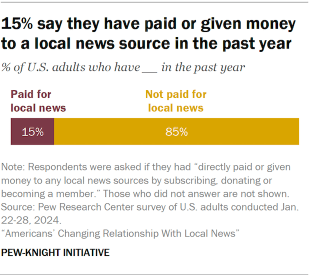A majority of Americans say they think their local news outlets are doing very or somewhat well financially. However, this share has decreased somewhat in recent years.

Today, 63% of U.S. adults say they think their local news outlets are doing very or somewhat well financially; 71% said the same in 2018, the last time we asked this question.
This change may be linked with real downward trends in the local news industry. Audiences for traditional local news media, including local TV stations and newspapers, have decreased in recent years. And newspaper revenue has been on a steep decline, although economic conditions for local TV, radio and digital news have been more mixed.

One of the biggest changes on this question has been among Americans with higher levels of education. About half of college graduates (52%) now say their local news organizations are doing very or somewhat well, down 13 percentage points from 65% in 2018. Those with a high school education or less, on the other hand, are about as likely as they were in 2018 to say their local news organizations are doing well financially (72% in 2024, 73% in 2018).
Americans who prefer to get their local news from television are more likely than others to think their local outlets in general are doing well. But those who prefer news websites, radio and print for local news are less likely to say this.

Although respondents were asked about the financial status of their local news outlets in general (and not just the platform they prefer), this nevertheless may reflect real economic conditions across different segments of the local news industry. Revenue has declined across some platforms, including daily newspapers, but local TV news stations have remained relatively stable in this regard.
Vast majority of Americans don’t pay for local news

The survey also asked respondents whether they had paid or given money to any local news source in the past year – whether by subscribing, donating or becoming a member. An overwhelming majority of Americans (85%) say no, while 15% say yes. These shares have not changed much since 2018, when 84% said no and 14% said yes.

Those who say they have not paid for local news in the past year were asked about the main reason they don’t pay. About half (49%) say there are plenty of free alternatives. Three-in-ten cite a lack of interest in local news, while 10% say the news is not good enough to pay for and 8% say it’s too expensive.

Americans’ reasons for not paying for local news vary based on age. Among U.S. adults ages 30 and older who have not paid for local news in the past year, the most common reason they cite is that they can find plenty of free local news.
But the most common reason given by Americans ages 18 to 29 is a lack of interest: 46% in this group say the main reason they don’t pay for local news is that they are not interested enough in it, while 37% say there are enough free alternatives.
Overall, 47% of adults under 30 say they follow local news very or somewhat closely, compared with 83% of those 65 and older.




